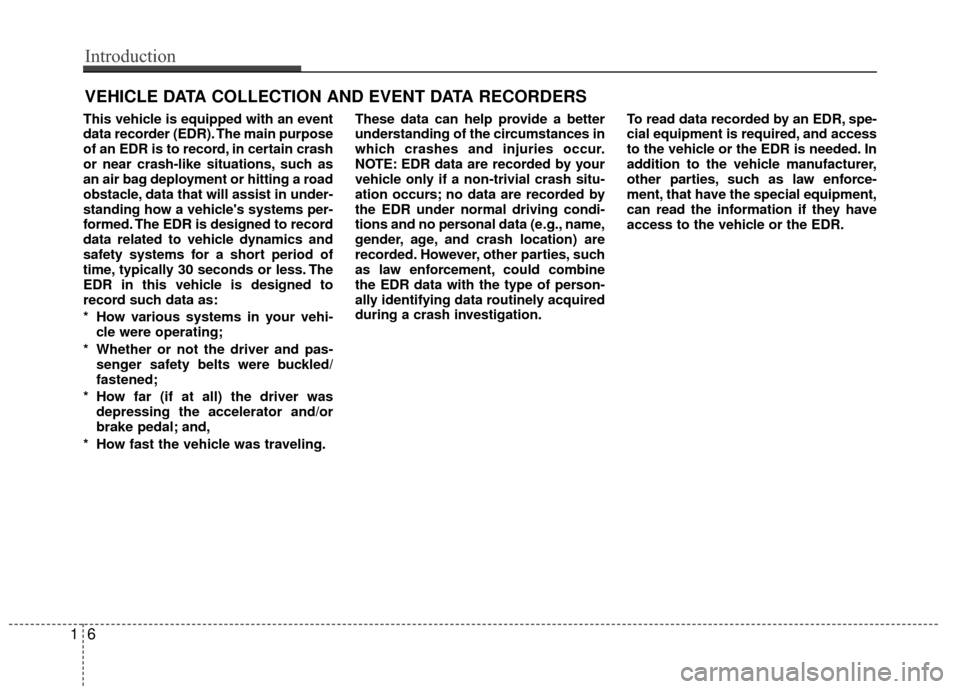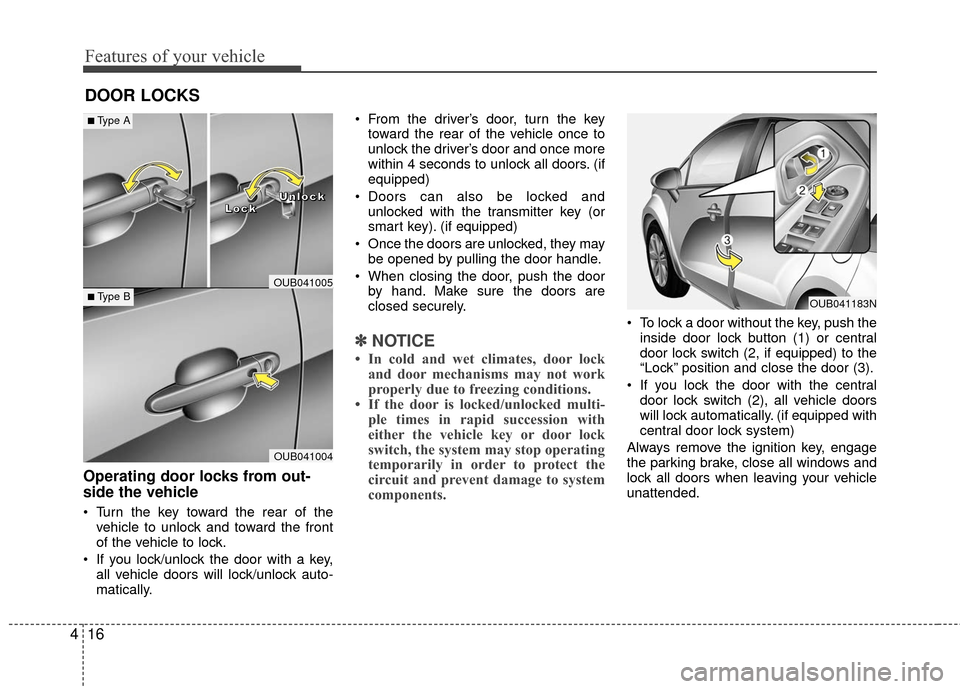2016 KIA Rio brake
[x] Cancel search: brakePage 8 of 449

15
Introduction
Use of MTBE
Kia recommends avoiding fuels contain-
ing MTBE (Methyl Tertiary Butyl Ether)
over 15.0% vol. (Oxygen Content 2.7%
weight) in your vehicle.
Fuel containing MTBE over 15.0% vol.
(Oxygen Content 2.7% weight) may
reduce vehicle performance and produce
vapor lock or hard starting.
✽ ✽
NOTICE
Your New Vehicle Limited Warranty may
not cover damage to the fuel system and
any performance problems that are
caused by the use of fuels containing
methanol or fuels containing MTBE
(Methyl Tertiary Butyl Ether) over 15.0%
vol. (Oxygen Content 2.7% weight.)
Do not use methanol
Fuels containing methanol (wood alco-
hol) should not be used in your vehicle.
This type of fuel can reduce vehicle per-
formance and damage components of
the fuel system, engine control system
and emission control system.
Fuel Additives
Kia recommends that you use good qual-
ity gasolines treated with detergent addi-
tives such as TOP TIER Detergent
Gasoline, which help prevent deposit for-
mation in the engine. These gasolines
will help the engine run cleaner and
enhance performance of the Emission
Control System. For more information on
TOP TIER Detergent Gasoline, please
go to the website (www
.toptiergas.com).
For customers who do not use TOP Tier
Detergent Gasoline regularly, and have
problems starting or the engine does not
run smoothly, additives that you can buy
separately may be added to the gasoline. If
TOP TIER Detergent Gasoline is not avail-
able, one bottle of additive added to the fuel
tank at every 12,000 km or every engine oil
change is recommended. Additives are
available from your authorized Kia dealer
along with information on how to use them.
Do not mix other additives.
Operation in foreign countries
If you are going to drive your vehicle in
another country, be sure to:
Observe all regulations regarding reg- istration and insurance.
Determine that acceptable fuel is avail- able. No special break-in period is needed. By
following a few simple precautions for the
first 1,000 km (600 miles) you may add to
the performance, economy and life of
your vehicle.
Do not race the engine.
While driving, keep your engine speed
(rpm, or revolutions per minute)
between 2,000 rpm and 4,000 rpm.
Do not maintain a single speed for long periods of time, either fast or slow.
Varying engine speed is needed to
properly break-in the engine.
Avoid hard stops, except in emergen- cies, to allow the brakes to seat prop-
erly.
Don't tow a trailer during the first 2,000 km (1,200 miles) of operation.
VEHICLE BREAK-IN PROCESS
Page 9 of 449

This vehicle is equipped with an event
data recorder (EDR). The main purpose
of an EDR is to record, in certain crash
or near crash-like situations, such as
an air bag deployment or hitting a road
obstacle, data that will assist in under-
standing how a vehicle's systems per-
formed. The EDR is designed to record
data related to vehicle dynamics and
safety systems for a short period of
time, typically 30 seconds or less. The
EDR in this vehicle is designed to
record such data as:
* How various systems in your vehi-cle were operating;
* Whether or not the driver and pas- senger safety belts were buckled/
fastened;
* How far (if at all) the driver was depressing the accelerator and/or
brake pedal; and,
* How fast the vehicle was traveling. These data can help provide a better
understanding of the circumstances in
which crashes and injuries occur.
NOTE: EDR data are recorded by your
vehicle only if a non-trivial crash situ-
ation occurs; no data are recorded by
the EDR under normal driving condi-
tions and no personal data (e.g., name,
gender, age, and crash location) are
recorded. However, other parties, such
as law enforcement, could combine
the EDR data with the type of person-
ally identifying data routinely acquired
during a crash investigation.
To read data recorded by an EDR, spe-
cial equipment is required, and access
to the vehicle or the EDR is needed. In
addition to the vehicle manufacturer,
other parties, such as law enforce-
ment, that have the special equipment,
can read the information if they have
access to the vehicle or the EDR.
VEHICLE DATA COLLECTION AND EVENT DATA RECORDERS
16
Introduction
Page 13 of 449

Your vehicle at a glance
42
INTERIOR OVERVIEW
OUB021001K
1. Door lock/unlock button ....................4-16
2. Central door lock switch....................4-17
3. Power window switches ....................4-24
4. Power window lock button ................4-27
5. Outside rearview mirror control switch ................................................4-41
6. Hood release lever ............................4-28
7. Fuel filler lid release lever .................4-30
8. Trunk lid release lever (4 door) .........4-20
9. Steering wheel ..................................4-37
10. Steering wheel tilt control lever.......4-38
11. Active ECO button ..........................5-43
12. Instrument panel illumination control switch ..............................................4-44
13. ESC OFF button .............................5-27
14. Heated steering wheel switch (if equipped) ....................................4-38
15. Idle Stop and Go system OFF button (if equipped) ....................................5-40
16. Fuse box .........................................7-62
17. Brake pedal .....................................5-22
18. Accelerator pedal
❈ The actual interior in the vehicle may differ from the illustration.
Page 14 of 449

25
Your vehicle at a glance
INSTRUMENT PANEL OVERVIEW
OUB025002N
1. Instrument cluster.............................4-43
2. Horn .................................................4-39
3. Driver’s front air bag .........................3-44
4. Light control/Turn signals .................4-73
5. Wiper/Washer ...................................4-77
6. Ignition switch or ENGINE START/STOP button .................................5-5, 5-7
7. Hazard warning flasher switch ......4-72, 6-2
8. Audio ..............................................4-121
9. Climate control system...............4-84, 94
10. Shift lever ...............................5-13, 5-16
11. Steering wheel audio control........4-122
12. Passenger’s front air bag ...............3-44
13. Glove box .....................................4-110
14. Parking brake lever ........................5-24
15. Power outlet .................................4-117
16. Cigarette lighter ............................4-114
17. Seat warmer .....................................3-8
❈ The actual instrument panel in the vehicle may differ from the illustration.
Page 15 of 449

Your vehicle at a glance
62
ENGINE COMPARTMENT
OUB071103N
* The actual engine compartment in the vehicle may differ from the illustration.1. Engine Coolant Reservoir ................7-36
2. Engine Oil Filler Cap ........................7-34
3. Brake/Clutch Fluid Reservoir ...........7-39
4. Air Cleaner .......................................7-41
5. Fuse Box ..........................................7-62
6. Negative Battery Terminal ................7-45
7. Positive Battery Terminal ..................7-45
8. Radiator Cap ....................................7-37
9. Engine Oil Dipstick ...........................7-34
10. Windshield Washer Fluid Reservoir..
7-40
Page 69 of 449

Safety features of your vehicle
54
3
Just before impact, drivers often brake
heavily. Such heavy braking lowers the
front portion of the vehicle causing it to
“ride” under a vehicle with a higher
ground clearance. Air bags may not
inflate in this "under-ride" situation
because deceleration forces that are
detected by sensors may be signifi-
cantly replaced by such “under-ride”
collisions. Air bags do not inflate in most rollover
accidents, even though the vehicle is
equipped with side impact air bags and
curtain air bags. Air bags may not inflate if the vehicle
collides with objects such as utility
poles or trees, where the point of
impact is concentrated to one area and
the full force of the impact is not deliv-
ered to the sensors.
1VQA2090OUB035046N1VQA2092
Page 87 of 449

Features of your vehicle
16
4
DOOR LOCKS
Operating door locks from out-
side the vehicle
Turn the key toward the rear of the
vehicle to unlock and toward the front
of the vehicle to lock.
If you lock/unlock the door with a key, all vehicle doors will lock/unlock auto-
matically. From the driver’s door, turn the key
toward the rear of the vehicle once to
unlock the driver’s door and once more
within 4 seconds to unlock all doors. (if
equipped)
Doors can also be locked and unlocked with the transmitter key (or
smart key). (if equipped)
Once the doors are unlocked, they may be opened by pulling the door handle.
When closing the door, push the door by hand. Make sure the doors are
closed securely.
✽ ✽ NOTICE
• In cold and wet climates, door lock
and door mechanisms may not work
properly due to freezing conditions.
• If the door is locked/unlocked multi- ple times in rapid succession with
either the vehicle key or door lock
switch, the system may stop operating
temporarily in order to protect the
circuit and prevent damage to system
components.
To lock a door without the key, push the
inside door lock button (1) or central
door lock switch (2, if equipped )to the
“Lock” position and close the door (3).
If you lock the door with the central door lock switch (2), all vehicle doors
will lock automatically. (if equipped with
central door lock system)
Always remove the ignition key, engage
the parking brake, close all windows and
lock all doors when leaving your vehicle
unattended.
OUB041004
■ Type B
■Type A
OUB041005
L
L
L
L
o
o
o
o
c
c
c
c
k
k
k
k U
U
U
U
n
n
n
n
l
l
l
l
o
o
o
o
c
c
c
c
k
k
k
k
OUB041183N
Page 99 of 449

Features of your vehicle
28
4
Opening the hood
1. Pull the release lever to unlatch the
hood. The hood should pop open
slightly.
Open the hood after turning off the
engine on a flat surface, shifting the shift
lever to the P(Park) position for automat-
ic transaxle and to the 1st(First) gear or
R(Reverse) for manual transaxle, and
setting the parking brake. 2. Go to the front of the vehicle, raise the
hood slightly, push the secondary latch
(1) inside of the hood center and lift
the hood (2). 3. Pull out the support rod from the hood.
4. Hold the hood opened with the support
rod.
HOOD
WARNING- Hot parts
Grasp the support rod in the area
wrapped in rubber. The plastic will
help prevent you from being burned
by hot metal when the engine is
hot.
OUB041021OUB045022LOUB041023